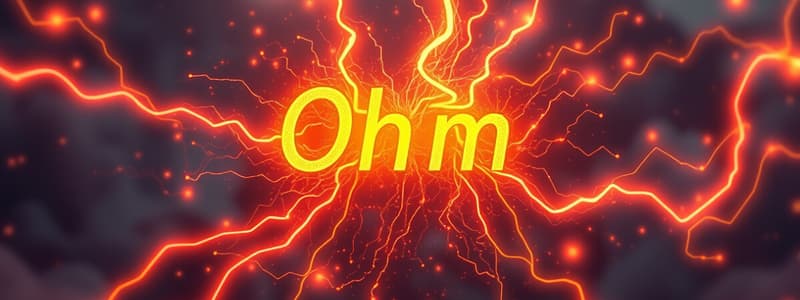Podcast
Questions and Answers
What is Ohm's Law?
What is Ohm's Law?
Ohm's Law states that the current through a conductor between two points is directly proportional to the voltage across the two points.
What is the unit for voltage?
What is the unit for voltage?
Volts
What is the unit for current?
What is the unit for current?
Amps
What is the unit for resistance?
What is the unit for resistance?
What is electricity?
What is electricity?
How is electricity formed?
How is electricity formed?
Static electricity is caused by _______ _______ charge by friction.
Static electricity is caused by _______ _______ charge by friction.
Current electricity is electrical charge that flows from one place to another through a _________.
Current electricity is electrical charge that flows from one place to another through a _________.
What is voltage?
What is voltage?
What is voltage measured with?
What is voltage measured with?
What is potential difference (pd)?
What is potential difference (pd)?
What is resistance?
What is resistance?
Current refers to the electrons that flow through the wires of the _________.
Current refers to the electrons that flow through the wires of the _________.
In a series circuit, if one light goes out then the circuit is broken.
In a series circuit, if one light goes out then the circuit is broken.
What happens if there's a break in a series circuit?
What happens if there's a break in a series circuit?
What happens to Ohm's Law in a series circuit as more bulbs are added? (Select all that apply)
What happens to Ohm's Law in a series circuit as more bulbs are added? (Select all that apply)
What happens to Ohm's Law in a parallel circuit as more bulbs are added? (Select all that apply)
What happens to Ohm's Law in a parallel circuit as more bulbs are added? (Select all that apply)
Current in a series circuit ________ at all points in the circuit.
Current in a series circuit ________ at all points in the circuit.
Current in a parallel circuit is ________ between the components.
Current in a parallel circuit is ________ between the components.
What is current measured with?
What is current measured with?
What is the definition of one Volt?
What is the definition of one Volt?
What is the definition of one Amp?
What is the definition of one Amp?
What is the definition of one Watt?
What is the definition of one Watt?
What is electrical power, expressed as a formula?
What is electrical power, expressed as a formula?
What is frequency?
What is frequency?
What is frequency measured in?
What is frequency measured in?
What defines AM waves?
What defines AM waves?
What defines FM waves?
What defines FM waves?
What is digital?
What is digital?
What is analog?
What is analog?
Flashcards are hidden until you start studying
Study Notes
Ohm's Law
- Fundamental principle relating voltage (V), current (I), and resistance (R) in an electrical circuit (V = IR).
Electrical Units
- Voltage is measured in Volts.
- Current is measured in Amps.
- Resistance is measured in Ohms.
Electricity Basics
- Electricity arises from charged particles, such as electrons and protons.
- Exists as static electricity (stationary charge) or current electricity (flowing charge).
Static and Current Electricity
- Static Electricity: Electricity generated by friction leading to charge accumulation; may cause sparks and attraction of small particles.
- Current Electricity: Flow of electrical charge typically through a conductor.
Voltage and Measurement
- Voltage is the force pushing current through a circuit.
- Measured using a Voltmeter.
- Potential difference varies across components and affects current; greater voltage results in higher current flow.
Resistance
- Resistance is the friction opposing the flow of current in a circuit.
- Measured as Ohms.
Circuit Types
- Closed Circuit: Current circulates without break; electrons flow in the opposite direction of the conventional current flow.
- Series Circuit: Components arranged in a single pathway; if one component fails, the entire circuit is disrupted.
- Parallel Circuit: Components connected across multiple paths; maintains functionality even if one component fails.
Circuit Characteristics
- In a series circuit:
- Voltage decreases with more bulbs added, current decreases, and resistance increases.
- Current remains the same at all points.
- In a parallel circuit:
- Voltage remains the same across all components, current increases with added bulbs, and total resistance decreases.
Component Connections
- In both series and parallel circuits, components have their ends connected; the setup influences circuit behavior.
Current Measurement
- Current is measured using an Ammeter.
Power and Frequency
- Electrical Power calculated using the formula P = IV.
- Frequency refers to the number of cycles per unit time, measured in Hertz (Hz).
Wave Types
- Alternating Current (AC): Charge reverses direction periodically.
- Direct Current (DC): Charge flows consistently in one direction.
Units of Measure
- One Volt equals one Joule per Coulomb (J/C).
- One Amp equals one Coulomb per second (C/s).
- One Watt equals one Joule per second (J/s).
AM vs FM
- AM Waves: Vary in amplitude, incorporating sound information into signal strength.
- FM Waves: Vary in frequency, providing improved sound quality less affected by environmental noise.
Digital vs. Analog
- Digital: Represents values as distinct on/off states (e.g., limit switches).
- Analog: Represents a continuum of values (e.g., light sensors).
Logic Gates
- Basic components of digital circuits, serving various logical functions contributing to circuit behavior.
Studying That Suits You
Use AI to generate personalized quizzes and flashcards to suit your learning preferences.




